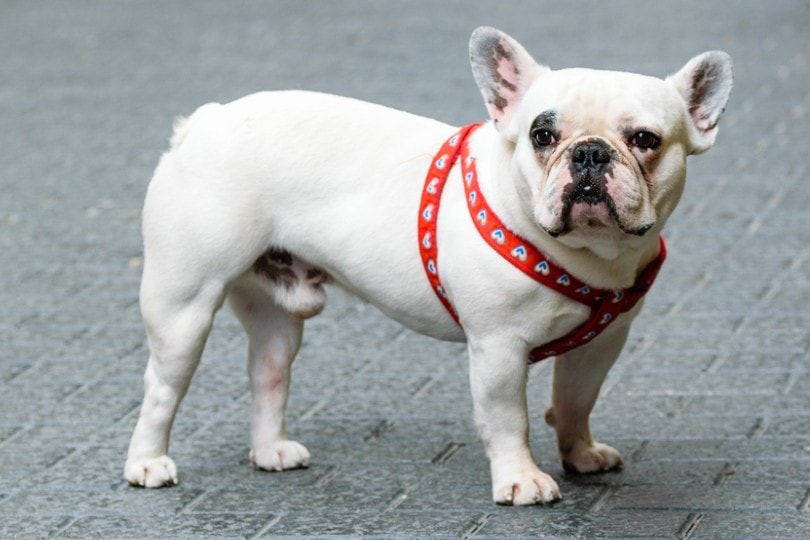Click to Skip Ahead
French Bulldogs are a popular breed of dog, known for their characteristic Frenchie face and bat-like ears. They come in a variety of colors, including brindle, black, and fawn. However, one coloration that is becoming increasingly popular is the white French Bulldog. White French Bulldogs are just like any other French Bulldog, except they have a white coat.
Breed Overview
Height:
Small to medium (11 – 12 inches)
Weight:
20 – 28 pounds for males, 16-24 pounds for females
Lifespan:
10 – 12 years
Colors:
Fawn, fawn and white, fawn brindle, brindle, brindle and white, cream, white and brindle, white and fawn
Suitable for:
Families looking for a playful, easy-to-groom lapdogs that does not require a lot of space.
Temperament:
Easygoing, sociable, gentle, friendly, playful, affectionate
The white French Bulldog has all of the same personality traits as the regular Frenchie, but they can be a little bit less common than other colorations of Frenchie, so if you’re looking for something unique, a white French Bulldog just might be the perfect dog for you! Read on to learn more about these gorgeous dogs.
French Bulldog Characteristics

The Earliest Records of White French Bulldogs in History
Despite its name, the French Bulldog originated in Nottingham, England, during the mid-1800s. Lacemakers in the area raised a lot of toy-size Bulldogs during that time in an effort to breed smaller dogs selectively. The toy bulldog became a mascot for this profession as a result. During the decline of the lacemaking industry in England, many workers relocated to the French countryside, where they developed distinctive traits in these smaller and smaller dogs. So, although originally from England, the breed was refined and improved in France until it became what we know today as the French Bulldog.
A crossbreeding between French Bulldogs and either terriers or pugs is believed to have resulted in Frenchies’ bat-like ears. One of the earliest depictions of an all-white French Bulldog is from this period,1 a white-glazed terracotta statue made in France sometime in the 1880s. The adorable appearance of Frenchies made them famous among Paris’ aristocracy, and from there they spread throughout the continent.

How White French Bulldog Gained Popularity
Before the 1950s most Frenchies were brindle with only a few pied and white dogs. During the 1950s, the colors in existence began to diversify. In a short time, there was an explosion of interest in more unusual colorations and a wide variety of colors and patterns present in French Bulldogs today. Breed standards allow some colors and forbid others. This is because some colors are connected to genetic defects, and, depending on its markings and parentage, the all-white Frenchie is a dog that can have serious hereditary health issues.
Formal Recognition of White French Bulldog
The American Kennel Club(AKC) does recognize pure white French Bulldogs as an acceptable coloration. In the Breed Standard, however, the AKC lists a number of disqualifiers that limit the type of white Frenchie that can be recognized. Some of these limitations are to stop unhealthy white dogs from being bred. These disqualifiers include a dog with blue or green eyes, or even any traces of blue or green in their eyes, noses with a color other than black, (although cream and fawn-colored dogs may have other lighter colored noses), and all coat colors other than those specifically described (which includes merle).
Genetic Factors with White French Bulldogs
It’s impossible to categorize white French Bulldogs into one genetic type. Many factors contribute to the rare presence of white French Bulldogs, including the genes for albinism, leucism, merle and double merle, and brindle or piebald.
Albinism
A white French Bulldog is not necessarily an albino dog. In fact, albino characteristics are not a significant cause of white Frenchies, because albinism is a recessive trait, meaning both parents must pass it on to their pups. An Albino French Bulldog’s eyes may be pink, blue, or amber and their blood vessels are often visible, so their skin is a bit pink. Albino puppies are prone to sunburn and have congenital sensory issues, so they may not live very healthy lives.
Leucism
In leucism, pigmentation is partially lost. Leucistic White Frenchies have spots of another color on their white coats. Leucism differs from albinism in that albinism is a complete lack of pigment. Leucism does not affect the color of the eye, while albinism does.
Brindle or Piebald
Brindles or piebalds are white French Bulldogs with markings. As long as they have a majority of the color white on their bodies, they are considered White Frenchies. There are many white-coat color and color markings allowed by the Breed Standard, including white and brindle, cream, cream and white, white and fawn, and white, brindle, and fawn.
Merle & Double Merle
Frenchies can have merle coats due to a genetic pattern. Merle genes can produce mottled patches of color on solid or piebald coats, blue or odd-colored eyes, and affect skin pigmentation. If two dogs with merle genes are mated, one-quarter of their puppies will be “double merles”. These dogs will also be white, but they are much more likely to have eye defects or be deaf. Even if these pups are born sighted and with hearing, they are much more likely to go blind and deaf as they age.
Top 3 Unique Facts About White French Bulldog
1. White Frenchies Shouldn’t Have Blue Eyes
The AKC will not allow White blue-eyed Frenchies to compete in shows since they are not standard. French Bulldogs with blue eyes are likely to carry the merle gene or albinism, and they are prone to several eye diseases, as well as deafness, and skin cancer.
2. White Frenchies Have Sensitive Skin
There is also a tendency for White Frenchies’ skin to be more sensitive to sunlight or exposure to other elements due to the fact that their skin contains a lesser amount of melanin. It is important to be aware of this when caring for a White French Bulldog and to take steps to help keep their skin healthy and free of irritation. You might want to limit their time outside or keep them shaded. You can also purchase doggie SPF for their sensitive parts.

3. A Cream-Colored or Piebald-Colored Frenchie Will Be a Healthier Dog
You are better off with a very pale cream colored or white with minimal piebald markings dog because these dogs will not have problematic genetics. Dogs bred with these colors are less likely to suffer from health issues, such as blindness, deafness, and skin issues. For this reason, it is important to only buy French Bulldogs from reputable breeders who follow the breed standard.

Does a White French Bulldog Make a Good Pet?
There is no one-size-fits-all answer to this question, as the suitability of a white French bulldog as a pet will depend on a variety of individual factors. However white French bulldogs can make great pets for the right person or family. They are typically friendly, playful, and loving animals that enjoy spending time with their human companions. They are also relatively low-maintenance pets, requiring relatively minimal grooming and exercise.
There are many factors to consider when assessing whether a white French bulldog would make a good pet for your home. Some things to think about include the dog’s temperament, exercise needs, and whether you have another pet that could potentially get along with a French bulldog.
Conclusion
In conclusion, the white French Bulldog is a unique and beautiful dog that deserves to be loved and appreciated. They are playful, loving, and make great pets. If you are considering adding a French Bulldog to your family, consider giving a white French Bulldog a chance. They may just be the perfect dog for you. However, if you are interested in owning a white French Bulldog, be sure to do your research and find a reputable breeder. Not all white French Bulldogs have been created in safe, responsible ways, and not all white French Bulldogs will be recognized by the AKC, so do your homework before buying your forever pup!
See also:
- Why Does a French Bulldog Get Skin Lumps? Our Vet Explains
- Black and White French Bulldog: Pictures, Care Guide, Info & More
Featured Image Credit: ElfinFox, Pixabay











